Samsung GalaxyTab 10.1 Review
The future of tablets seems pretty bright to me - whatever you say, but for many this is the most successful form factor. Now everyone who is not lazy has taken up their production - it’s only a pity that for more than a year now the quantity has not developed into quality.
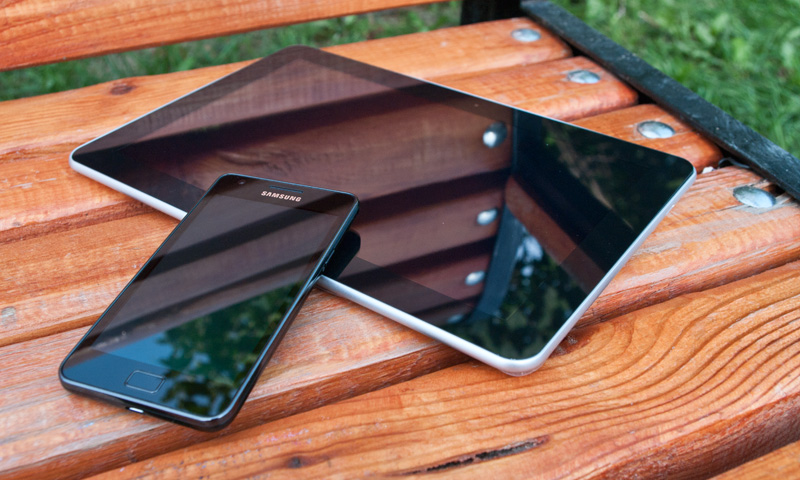
But Samsung did it.
It’s quite difficult to talk about tablets without mentioning one well-known company - if not for it .... not, tablets, of course, would have appeared sooner or later, but the protagonist of today's review had every chance to enter the market at another time and in a different way. Therefore, I thank you in advance for your understanding - I will write a review with an eye to the experience of using a tablet from that well-known company.
OS: Android 3.1 with TouchWiz shell
Processor: nVidia Tegra 2, 1.1 GHz, 2 cores
Memory: 16/32/64 GB (without a memory card slot)
RAM: 1 GB DDR-II
Display: 10.1 ", 1280x800 (16:10), TFT PLS
Connectors: microSIM, proprietary USB, 3.5 mm minijack
Communication: 3G, EDGE, HSCSD, HSDPA, HSUPA, GPRS, GSM900 / 1800/1900, Wi-Fi 802.11b / g / n, Bluetooth 3.0
Navigation: GPS (A-GPS), accelerometer, gyroscope, electronic compass
Cameras: 3 megapixels (rear) + 2 megapixels (front); flash, autofocus
Battery: 7000 mAh (up to 10 hours of operation)
Dimensions: 257 x 175 x 8.6 mm
Weight:565 grams
Price: from 23,990 rubles
In the pursuit of sensations, megapixels and gigahertz, manufacturers forget about such basic things as the equipment of devices - this is what you pay attention to first of all, “they are greeted by clothes”. Not a lot, but not empty:
- The tablet itself
- A charger + a removable plug
- A USB cable (for synchronization and charging)
-
There was no stereo headset , but I found it (in Russian) on the net - there are 128 pages on it pretty detailed.
Do not be surprised if the appearance of the USB cable and the connector on the tablet reminds you something - the painfully familiar interface allows you to not only charge the device and connect it to the computer, but also display the image via HDMI (this adapter will have to be purchased separately). Oh, and you could fit the same thing into microUSB.
In the hands of the difference between the iPad and the new tablet from Samsung is small - the dimensions and weight are approximately the same, although there are two noticeable differences: different aspect ratios of the screens (4: 3 versus 16:10 for the new product) and body materials. The Galaxy Tab 10.1 case is entirely made of plastic, there is not the slightest hint of metal in it (which is a pity) - apparently, due to this, it was possible to “fit” into 565 grams of weight. The device turned out to be record-breaking thin - only 8.6 mm, which is a little thinner than the second iPad.
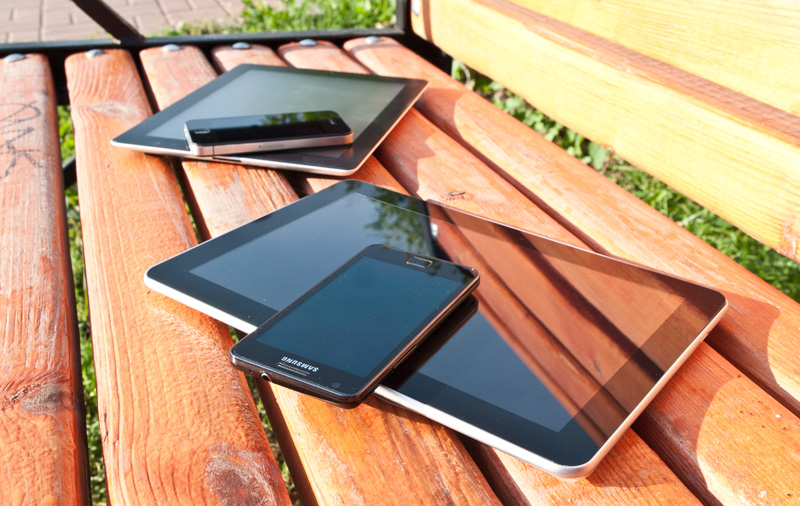
On the front side of the tablet there is only a screen and a hidden front camera (2 megapixels) above it. Habit is a terrible force, so the first time I involuntarily tried to find the Home button, which is not here. At first, it was somewhat annoying - instead, you have to use the touch button on the display, which is not tactile and always occupies part of the screen.

The basis of the capacitive screen is Samsung’s own development, the PLS ( Plane to Line Switching ) matrix , which supposedly provides 10% greater brightness compared to IPS-matrices. I did not take any measurements, but, looking ahead, the screen is beautiful. As you might guess from the name of the device, its diagonal is 10.1 inches, and the resolution is 1280x800.
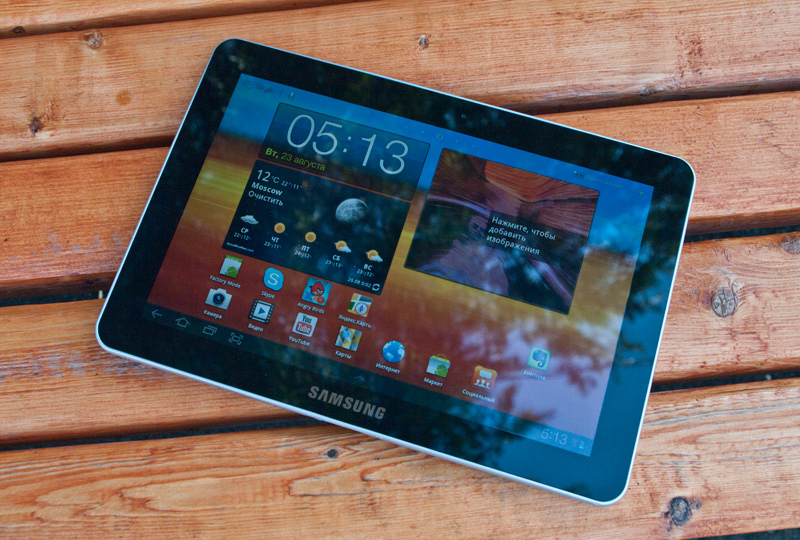
As with most Samsung devices, the well-proven Gorilla Glass is used here . But it, unfortunately, does not have an oleophobic (repellent grease) coating, which is why the display is quickly covered with fingerprints.
The edges are not sharp, “cut” about them is impossible. All corners are rounded. At the top of the tablet is a microSIM card slot, a mini-jack for headphones, a volume rocker and a power button. Bottom - dock-connector and the "point" of the microphone.
And on the side ends are two small stereo speakers with a protective mesh.
Those who followed the tablet’s development history noticed changes on the back of the device — it has changed significantly externally. Now there is nothing superfluous on it, except for the 3.2-megapixel camera and flash. There, as I said, solid plastic - now it is sold in an almost non-dirty white color, but the black color of the case is about to appear.

Well, perhaps the description of the appearance of the device is everything, although everything described was immediately visible. There was almost no need to re-get used to ergonomics; in this regard, they did not begin to reinvent the wheel.

In general, everything is fine, although, of course, the metal case of the iPad is somewhat spoiled - after this, the plastic is perceived somewhat differently, even if it is monolithic and does not give up before deformations. There are not so many accessories - a keyboard, a docking station and a pair of covers - not a lot, but still ahead.
Exactly 40 seconds elapse from the moment the power button is pressed until the device is fully turned on, and half of this time is the company screensaver. Immediately after that, a red-red lock screen with a clock appears in front of the user.
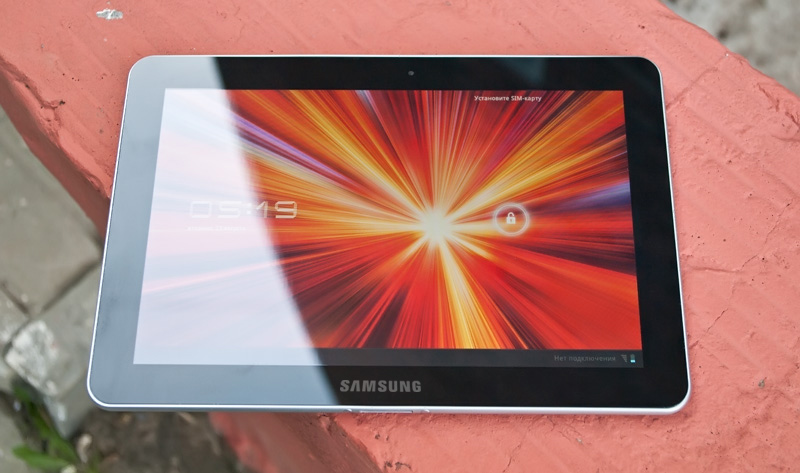
Well, quite bright for a start - Samsung is not the first time to apply such a trick, demonstrating all the charms of its screens in juicy pictures. The main thing here is that there should be something to surprise then - after all, in the same iPad the neutral fading image is initially set, and all the delights of the IPS matrix are recognized only with time. But the Galaxy Tab has a very bright screen, it’s very direct - in the dark there is even some discomfort from its maximum brightness. In the sun, the screen fades significantly, but the information remains readable.

The unlock screen was interestingly executed, in which you need to pull the ring with a “lock” around the perimeter of the large ring - all this is somewhat reminiscent of the unlock screen in HTC Sense, although all the similarities end there.
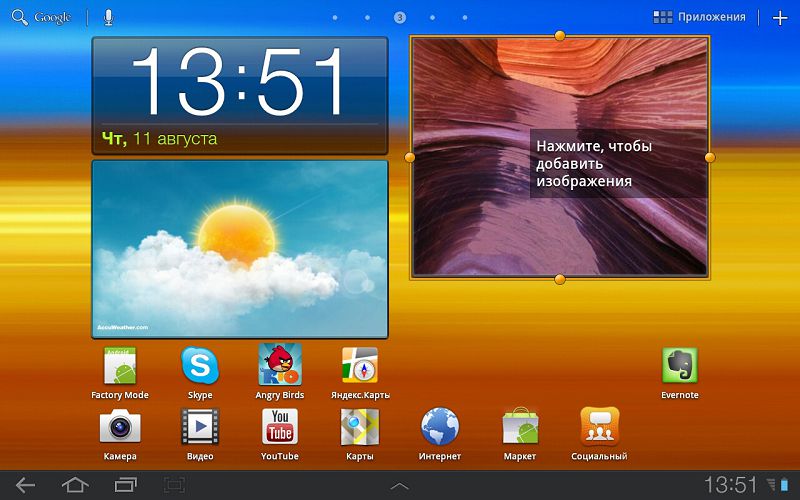
The device uses Android 3.1 OS with the latest version of the proprietary graphic interface TouchWiz. Initially, there are five “desktops” on the screen, on some of which various icons and third-party widgets are conveniently located - Ap Mobile (news widget), mail, time, weather, photo album, Social Hub and Readers Hub (a kind of content aggregators), calendar Yahoo! Finance and others. There is also a kind of dock - by default it is automatically hidden, but you can call it at any time and run some application from it. All this was done quite nicely and, as it seems to me, the rally “beats” the iPad. In the future, this impression is only confirmed - the flexibility of the interface is incomparably greater than in iOS. At least for the average geek of a place for flight of fantasy - a plowed field.
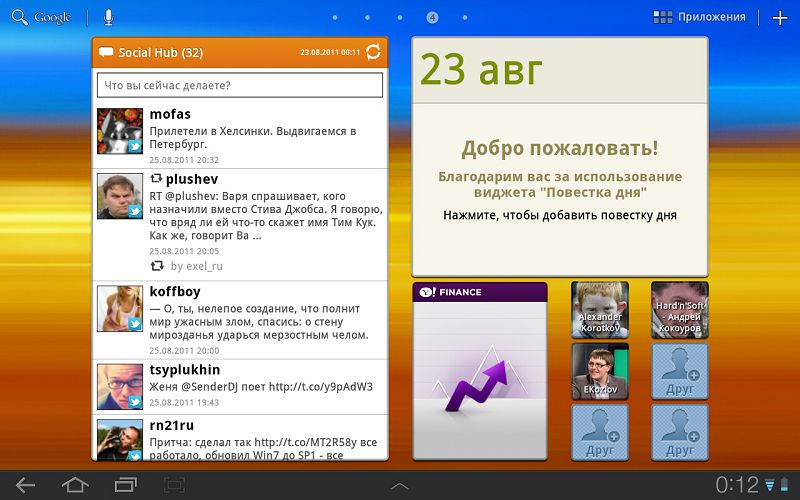
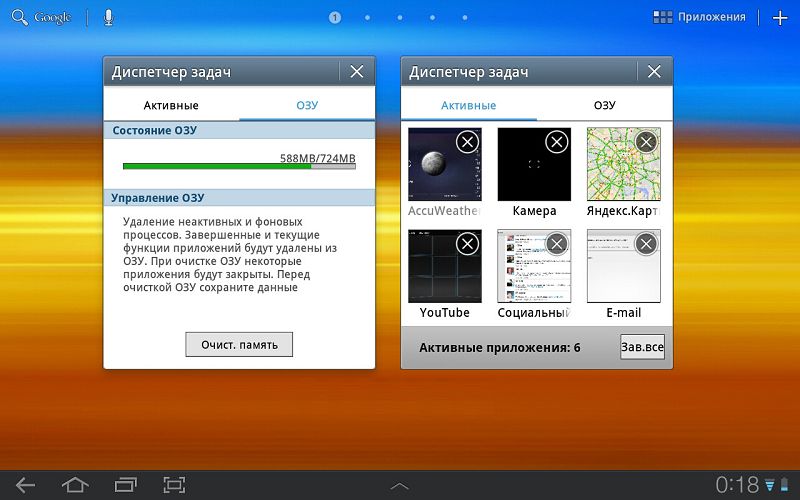
Now is the time to express gratitude to Samsung for the opportunity to take screenshots “humanly” - a separate button has already been moved to the taskbar!
But the interface is an interface, and it’s better to immediately remove the superfluous - unfortunately, even “out of the box” the shell significantly slows down. When switching between screens, this is almost not felt, but when changing the orientation of the image from portrait to landscape - more than. Accordingly, it is not clear what will happen in the future when the user installs at least a dozen or two applications ... I doubt that it will work faster.
Nevertheless, the performance is quite good - everything quickly switches, moves and scales - whether it be large photos, an open site or any maps. The dual-core NVIDIA Tegra 2 processor makes itself felt ... and the network already has options for how to “unlock” it up to 1.4 GHz.
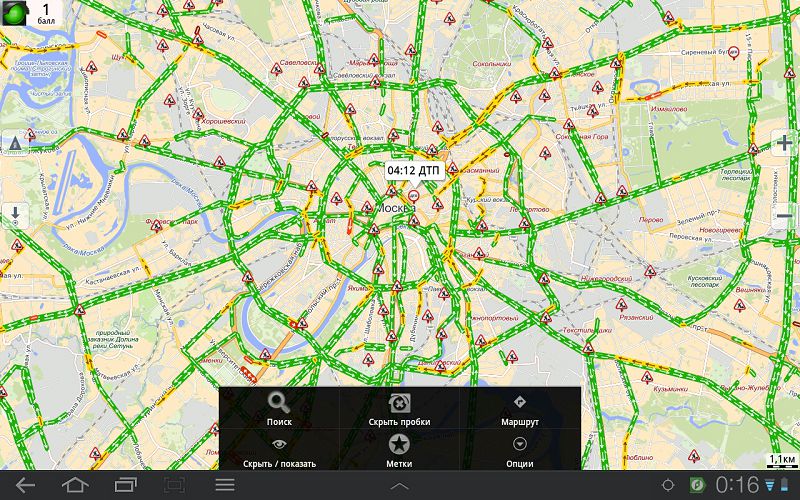
Unlike iOS, here you can move icons almost arbitrarily (the grid for them is much larger) and widgets (many can be transformed) - all this allows you to conveniently organize your workspace. There are no beauties like in HTC Sense, but overall it also looks very good:
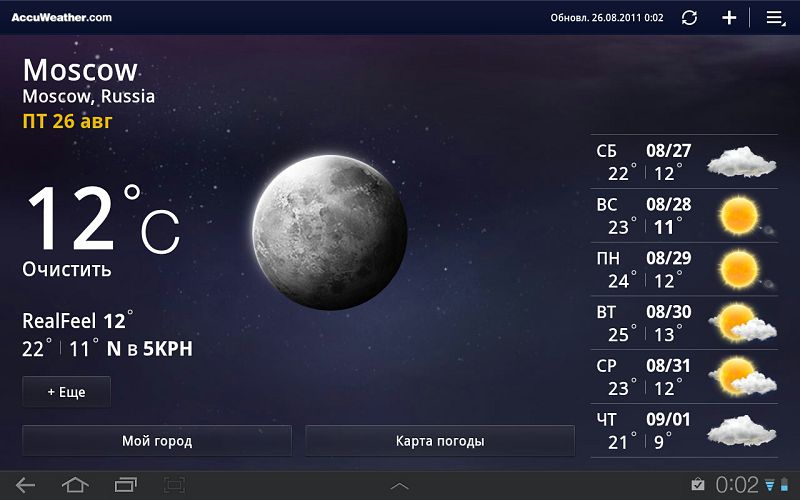
A long tap in an empty place (or clicking on the “+” in the upper right corner) brings up the settings window, from where you can place anything from a predefined arsenal on the selected screen (applications, widgets, wallpapers or something more unusual - bookmark, contact, route , Gmail shortcut, etc.).


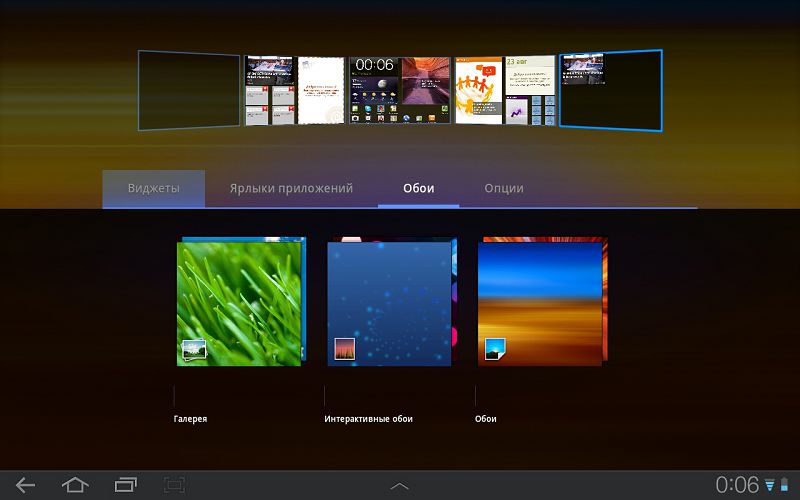

The native browser is not bad, most of all in it I was surprised by the possibility of scaling by tilting the device (with two fingers on the screen) and the toolbars appearing at the edges - a rather unusual solution.

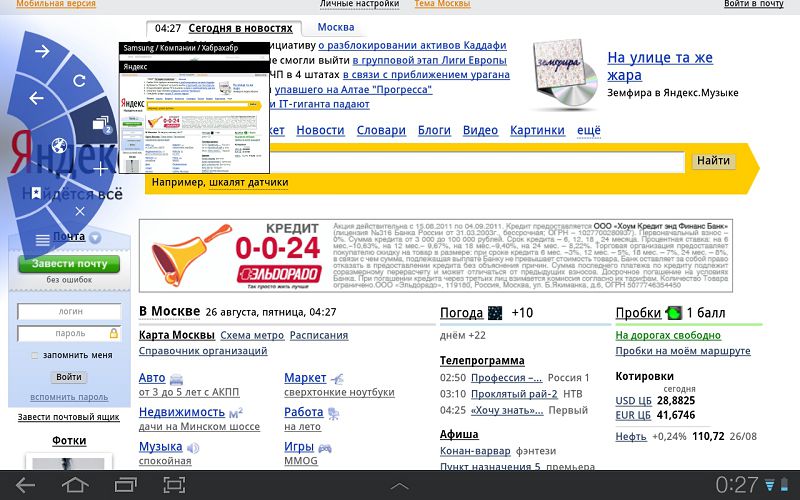

Initially, several applications are preinstalled, for example Polaris Office (office suite), Pulse News (an application for reading news channels), Pen memo (handwritten notes), uTalk (messenger) and Samsung Apps (Samsung’s own app store). Everything else is on its own.

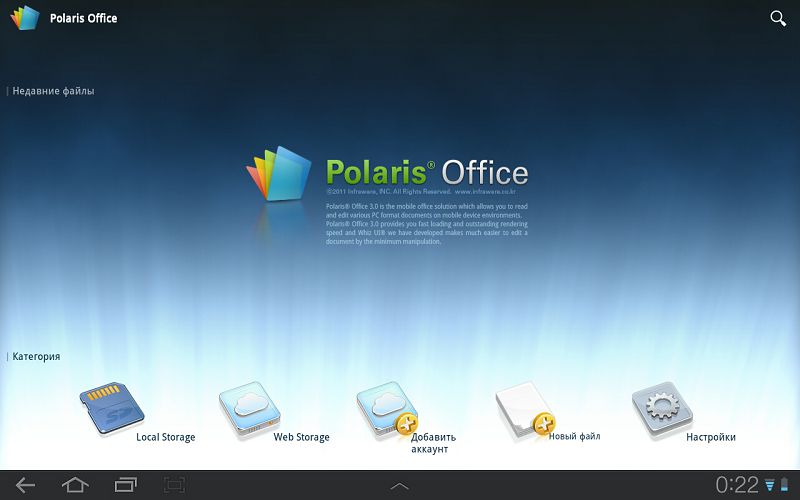
Installing applications is standard - go to the market and download. Installation is a little more difficult than installing on iOS, but there will be no problems. Although no, there are still some problems - there are not as many applications for the tablet at the moment that we would like. It is hoped that the situation will change for the better over time.
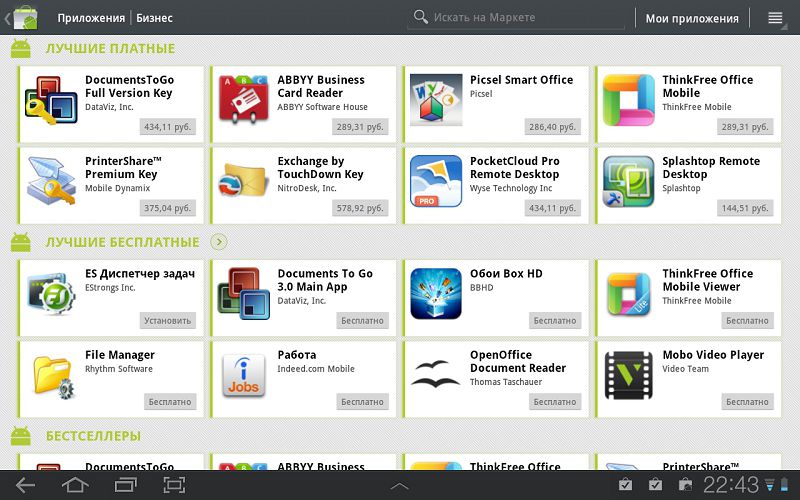

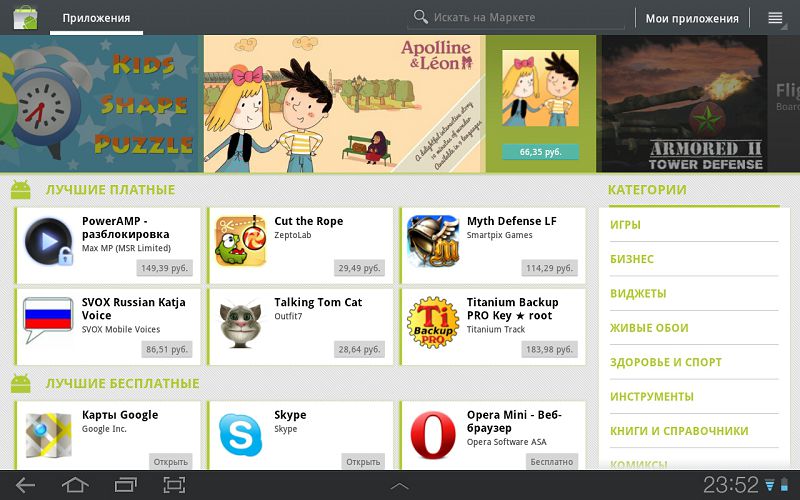

By the way, the notorious w3bsit3-dns.com resource in this regard is very convenient - there is an excellent rubric of applications, from which it is immediately clear what is suitable for a tablet and what is not.
Some standard applications:
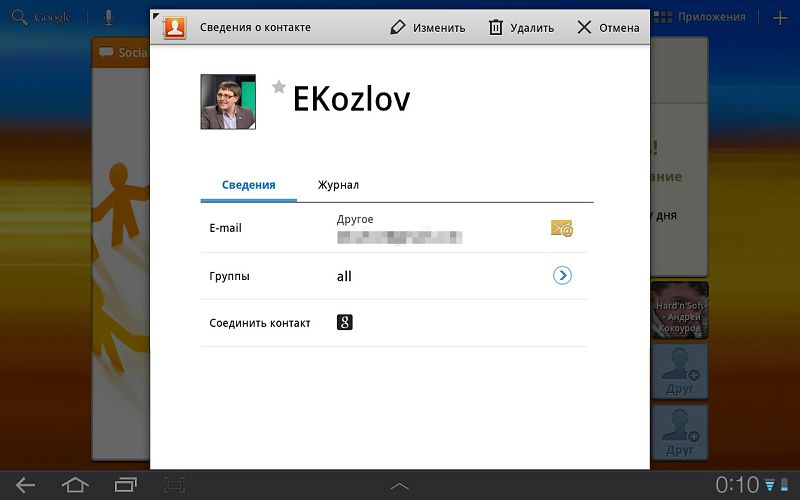

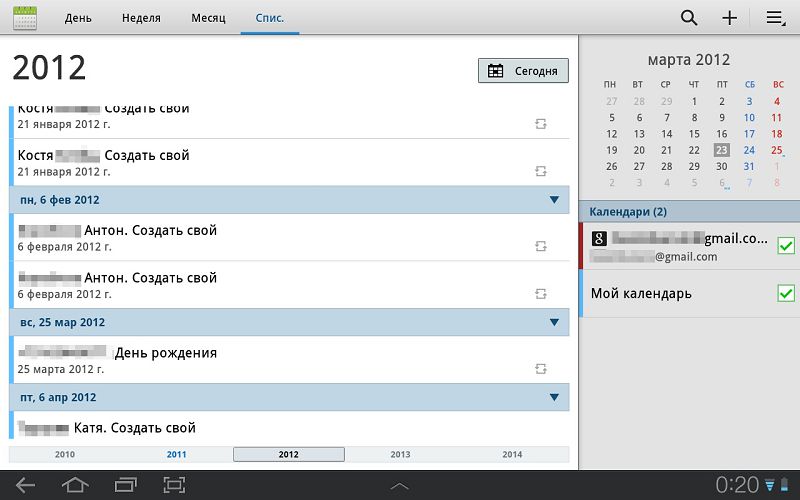
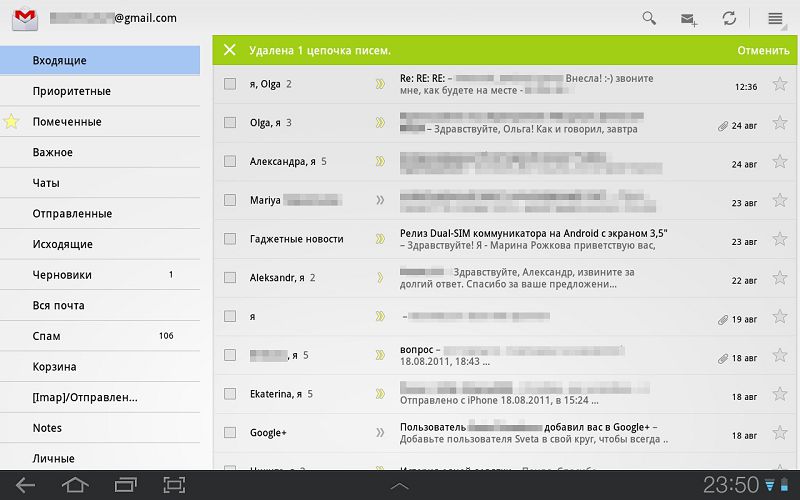
Youtube:


Entering text, as it is not surprising, is carried out using the on-screen keyboard - it is quite convenient (there are actually several of them), but when I saw that Swype was preinstalled there, I switched to it without the slightest thought. This method of data entry is so convenient (if you get the hang of it) that typing on the touch screen can be no slower than on a regular keyboard!
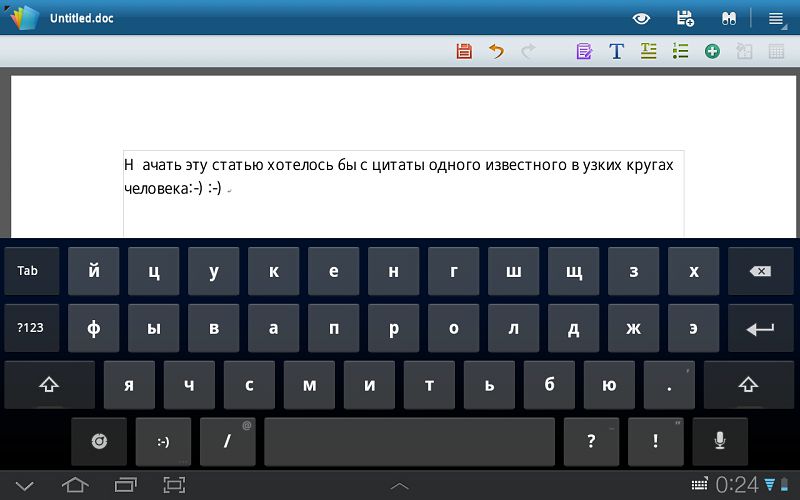

You will not complain about the quality of the camera - it is better than that of competitors. In this matter, Samsung has recently been very successful, as it seems to me. Examples of photos:


System settings:



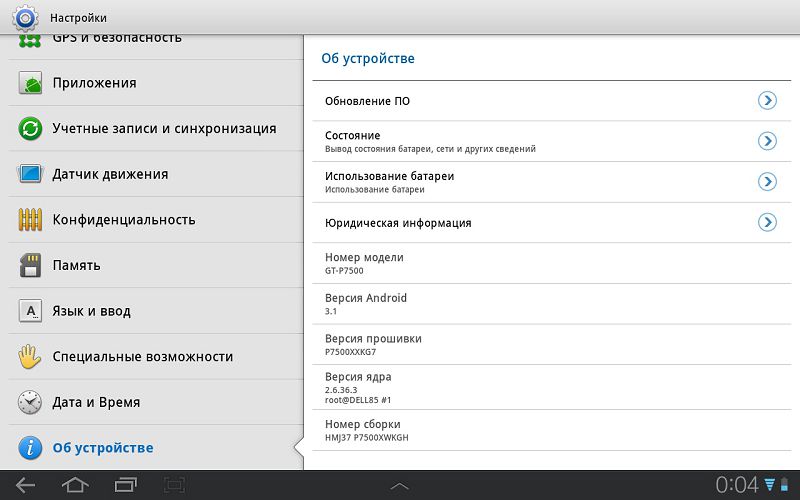
The tablet is defined in the system (Win) as a portable device GT-P7500 - you can upload something or merge photos. When connected to a computer’s USB port, the tablet does not charge.
Over time, everything is surprisingly good - the android easily works (at automatic screen brightness) for about 9 hours, and someone manages to squeeze more! A very worthy result - for a "working day" and this is enough for the road.
For a more detailed overview of the insides, see these videos:
✔ Compact size, comfortable weight
✔ High-quality and very bright screen
✔ Android OS - freedom of action, gaining momentum
✔ Sufficient performance in most tasks
✔ Competitive battery life (about 9 hours)
✔ The presence of vibration signal for feedback
✘ Plastic case and a very easily-visible display
✘ There is no slot for a memory card, but it could have been
✘ Not the smoothest interface speed
✘ The case heats up significantly during active work
✘ Quite a high price even for a younger model
Speaking of prices. You probably already heard about numerous lawsuits around Samsung devices, but fortunately Russia didn’t touch on this - sales started on August 25th, as planned. The recommended retail price for the younger model Samsung Galaxy Tab 10.1 (16GB with 3G / Wi-Fi) in a white case is 23,990 rubles, other configurations (including in black) will appear in the near future. Although comparable to the price of the second iPad, but still quite expensive - users had to be taken at a lower price!
The advantages of Samsung include the presence of a whole range of devices, in which there is an equally interesting version of the tablet, Galaxy Tab 8.9 . Even in this situation, it will be very difficult to seriously shake Apple’s position, but now users at least have a decent alternative - the choice is always great.
It's nice that the company did not rush to release the device and chose to bring it to mind - there is nothing to complain about in terms of the hardware itself. Software - yes, there are a lot of roughnesses (namely, Android), which to some extent will be nice to file with a file. Ergonomics of applications is completely different (it will be more difficult for a child to master such an interface than on an iPad), but on the other hand - why do we need two identical OS?
Fair? To the maximum extent, I don’t care who is there and when the tablet was invented, patent wars are already literally dreaming. I also do not take responsibility for dotting i in the “iPad vs Galaxy Tab” holivar - another bad job. But one thing is clear - it is unambiguous for tablets to be, therefore, what to choose - let everyone decide for himself, starting from their capabilities and needs. But without a doubt in my voice, I’ll say that the Samsung Galaxy Tab 10.1 is the first tablet capable of competing with the iPad in terms of technical specifications - it’s even strange that this happened only a year and a half after the first one was released.

But Samsung did it.
It’s quite difficult to talk about tablets without mentioning one well-known company - if not for it .... not, tablets, of course, would have appeared sooner or later, but the protagonist of today's review had every chance to enter the market at another time and in a different way. Therefore, I thank you in advance for your understanding - I will write a review with an eye to the experience of using a tablet from that well-known company.
Specifications
OS: Android 3.1 with TouchWiz shell
Processor: nVidia Tegra 2, 1.1 GHz, 2 cores
Memory: 16/32/64 GB (without a memory card slot)
RAM: 1 GB DDR-II
Display: 10.1 ", 1280x800 (16:10), TFT PLS
Connectors: microSIM, proprietary USB, 3.5 mm minijack
Communication: 3G, EDGE, HSCSD, HSDPA, HSUPA, GPRS, GSM900 / 1800/1900, Wi-Fi 802.11b / g / n, Bluetooth 3.0
Navigation: GPS (A-GPS), accelerometer, gyroscope, electronic compass
Cameras: 3 megapixels (rear) + 2 megapixels (front); flash, autofocus
Battery: 7000 mAh (up to 10 hours of operation)
Dimensions: 257 x 175 x 8.6 mm
Weight:565 grams
Price: from 23,990 rubles
In the pursuit of sensations, megapixels and gigahertz, manufacturers forget about such basic things as the equipment of devices - this is what you pay attention to first of all, “they are greeted by clothes”. Not a lot, but not empty:
- The tablet itself
- A charger + a removable plug
- A USB cable (for synchronization and charging)
-
There was no stereo headset , but I found it (in Russian) on the net - there are 128 pages on it pretty detailed.
Do not be surprised if the appearance of the USB cable and the connector on the tablet reminds you something - the painfully familiar interface allows you to not only charge the device and connect it to the computer, but also display the image via HDMI (this adapter will have to be purchased separately). Oh, and you could fit the same thing into microUSB.
Appearance
In the hands of the difference between the iPad and the new tablet from Samsung is small - the dimensions and weight are approximately the same, although there are two noticeable differences: different aspect ratios of the screens (4: 3 versus 16:10 for the new product) and body materials. The Galaxy Tab 10.1 case is entirely made of plastic, there is not the slightest hint of metal in it (which is a pity) - apparently, due to this, it was possible to “fit” into 565 grams of weight. The device turned out to be record-breaking thin - only 8.6 mm, which is a little thinner than the second iPad.

On the front side of the tablet there is only a screen and a hidden front camera (2 megapixels) above it. Habit is a terrible force, so the first time I involuntarily tried to find the Home button, which is not here. At first, it was somewhat annoying - instead, you have to use the touch button on the display, which is not tactile and always occupies part of the screen.

The basis of the capacitive screen is Samsung’s own development, the PLS ( Plane to Line Switching ) matrix , which supposedly provides 10% greater brightness compared to IPS-matrices. I did not take any measurements, but, looking ahead, the screen is beautiful. As you might guess from the name of the device, its diagonal is 10.1 inches, and the resolution is 1280x800.

As with most Samsung devices, the well-proven Gorilla Glass is used here . But it, unfortunately, does not have an oleophobic (repellent grease) coating, which is why the display is quickly covered with fingerprints.
The edges are not sharp, “cut” about them is impossible. All corners are rounded. At the top of the tablet is a microSIM card slot, a mini-jack for headphones, a volume rocker and a power button. Bottom - dock-connector and the "point" of the microphone.
And on the side ends are two small stereo speakers with a protective mesh.
Those who followed the tablet’s development history noticed changes on the back of the device — it has changed significantly externally. Now there is nothing superfluous on it, except for the 3.2-megapixel camera and flash. There, as I said, solid plastic - now it is sold in an almost non-dirty white color, but the black color of the case is about to appear.

Well, perhaps the description of the appearance of the device is everything, although everything described was immediately visible. There was almost no need to re-get used to ergonomics; in this regard, they did not begin to reinvent the wheel.

In general, everything is fine, although, of course, the metal case of the iPad is somewhat spoiled - after this, the plastic is perceived somewhat differently, even if it is monolithic and does not give up before deformations. There are not so many accessories - a keyboard, a docking station and a pair of covers - not a lot, but still ahead.
Software
Exactly 40 seconds elapse from the moment the power button is pressed until the device is fully turned on, and half of this time is the company screensaver. Immediately after that, a red-red lock screen with a clock appears in front of the user.

Well, quite bright for a start - Samsung is not the first time to apply such a trick, demonstrating all the charms of its screens in juicy pictures. The main thing here is that there should be something to surprise then - after all, in the same iPad the neutral fading image is initially set, and all the delights of the IPS matrix are recognized only with time. But the Galaxy Tab has a very bright screen, it’s very direct - in the dark there is even some discomfort from its maximum brightness. In the sun, the screen fades significantly, but the information remains readable.

The unlock screen was interestingly executed, in which you need to pull the ring with a “lock” around the perimeter of the large ring - all this is somewhat reminiscent of the unlock screen in HTC Sense, although all the similarities end there.

The device uses Android 3.1 OS with the latest version of the proprietary graphic interface TouchWiz. Initially, there are five “desktops” on the screen, on some of which various icons and third-party widgets are conveniently located - Ap Mobile (news widget), mail, time, weather, photo album, Social Hub and Readers Hub (a kind of content aggregators), calendar Yahoo! Finance and others. There is also a kind of dock - by default it is automatically hidden, but you can call it at any time and run some application from it. All this was done quite nicely and, as it seems to me, the rally “beats” the iPad. In the future, this impression is only confirmed - the flexibility of the interface is incomparably greater than in iOS. At least for the average geek of a place for flight of fantasy - a plowed field.


Now is the time to express gratitude to Samsung for the opportunity to take screenshots “humanly” - a separate button has already been moved to the taskbar!
But the interface is an interface, and it’s better to immediately remove the superfluous - unfortunately, even “out of the box” the shell significantly slows down. When switching between screens, this is almost not felt, but when changing the orientation of the image from portrait to landscape - more than. Accordingly, it is not clear what will happen in the future when the user installs at least a dozen or two applications ... I doubt that it will work faster.
Nevertheless, the performance is quite good - everything quickly switches, moves and scales - whether it be large photos, an open site or any maps. The dual-core NVIDIA Tegra 2 processor makes itself felt ... and the network already has options for how to “unlock” it up to 1.4 GHz.

Unlike iOS, here you can move icons almost arbitrarily (the grid for them is much larger) and widgets (many can be transformed) - all this allows you to conveniently organize your workspace. There are no beauties like in HTC Sense, but overall it also looks very good:

A long tap in an empty place (or clicking on the “+” in the upper right corner) brings up the settings window, from where you can place anything from a predefined arsenal on the selected screen (applications, widgets, wallpapers or something more unusual - bookmark, contact, route , Gmail shortcut, etc.).




The native browser is not bad, most of all in it I was surprised by the possibility of scaling by tilting the device (with two fingers on the screen) and the toolbars appearing at the edges - a rather unusual solution.



Initially, several applications are preinstalled, for example Polaris Office (office suite), Pulse News (an application for reading news channels), Pen memo (handwritten notes), uTalk (messenger) and Samsung Apps (Samsung’s own app store). Everything else is on its own.


Installing applications is standard - go to the market and download. Installation is a little more difficult than installing on iOS, but there will be no problems. Although no, there are still some problems - there are not as many applications for the tablet at the moment that we would like. It is hoped that the situation will change for the better over time.




By the way, the notorious w3bsit3-dns.com resource in this regard is very convenient - there is an excellent rubric of applications, from which it is immediately clear what is suitable for a tablet and what is not.
Some standard applications:




Youtube:


Entering text, as it is not surprising, is carried out using the on-screen keyboard - it is quite convenient (there are actually several of them), but when I saw that Swype was preinstalled there, I switched to it without the slightest thought. This method of data entry is so convenient (if you get the hang of it) that typing on the touch screen can be no slower than on a regular keyboard!


You will not complain about the quality of the camera - it is better than that of competitors. In this matter, Samsung has recently been very successful, as it seems to me. Examples of photos:


System settings:




The tablet is defined in the system (Win) as a portable device GT-P7500 - you can upload something or merge photos. When connected to a computer’s USB port, the tablet does not charge.
Over time, everything is surprisingly good - the android easily works (at automatic screen brightness) for about 9 hours, and someone manages to squeeze more! A very worthy result - for a "working day" and this is enough for the road.
For a more detailed overview of the insides, see these videos:
Pros and cons
✔ Compact size, comfortable weight
✔ High-quality and very bright screen
✔ Android OS - freedom of action, gaining momentum
✔ Sufficient performance in most tasks
✔ Competitive battery life (about 9 hours)
✔ The presence of vibration signal for feedback
✘ Plastic case and a very easily-visible display
✘ There is no slot for a memory card, but it could have been
✘ Not the smoothest interface speed
✘ The case heats up significantly during active work
✘ Quite a high price even for a younger model
Speaking of prices. You probably already heard about numerous lawsuits around Samsung devices, but fortunately Russia didn’t touch on this - sales started on August 25th, as planned. The recommended retail price for the younger model Samsung Galaxy Tab 10.1 (16GB with 3G / Wi-Fi) in a white case is 23,990 rubles, other configurations (including in black) will appear in the near future. Although comparable to the price of the second iPad, but still quite expensive - users had to be taken at a lower price!
Conclusion
The advantages of Samsung include the presence of a whole range of devices, in which there is an equally interesting version of the tablet, Galaxy Tab 8.9 . Even in this situation, it will be very difficult to seriously shake Apple’s position, but now users at least have a decent alternative - the choice is always great.
It's nice that the company did not rush to release the device and chose to bring it to mind - there is nothing to complain about in terms of the hardware itself. Software - yes, there are a lot of roughnesses (namely, Android), which to some extent will be nice to file with a file. Ergonomics of applications is completely different (it will be more difficult for a child to master such an interface than on an iPad), but on the other hand - why do we need two identical OS?
Fair? To the maximum extent, I don’t care who is there and when the tablet was invented, patent wars are already literally dreaming. I also do not take responsibility for dotting i in the “iPad vs Galaxy Tab” holivar - another bad job. But one thing is clear - it is unambiguous for tablets to be, therefore, what to choose - let everyone decide for himself, starting from their capabilities and needs. But without a doubt in my voice, I’ll say that the Samsung Galaxy Tab 10.1 is the first tablet capable of competing with the iPad in terms of technical specifications - it’s even strange that this happened only a year and a half after the first one was released.
